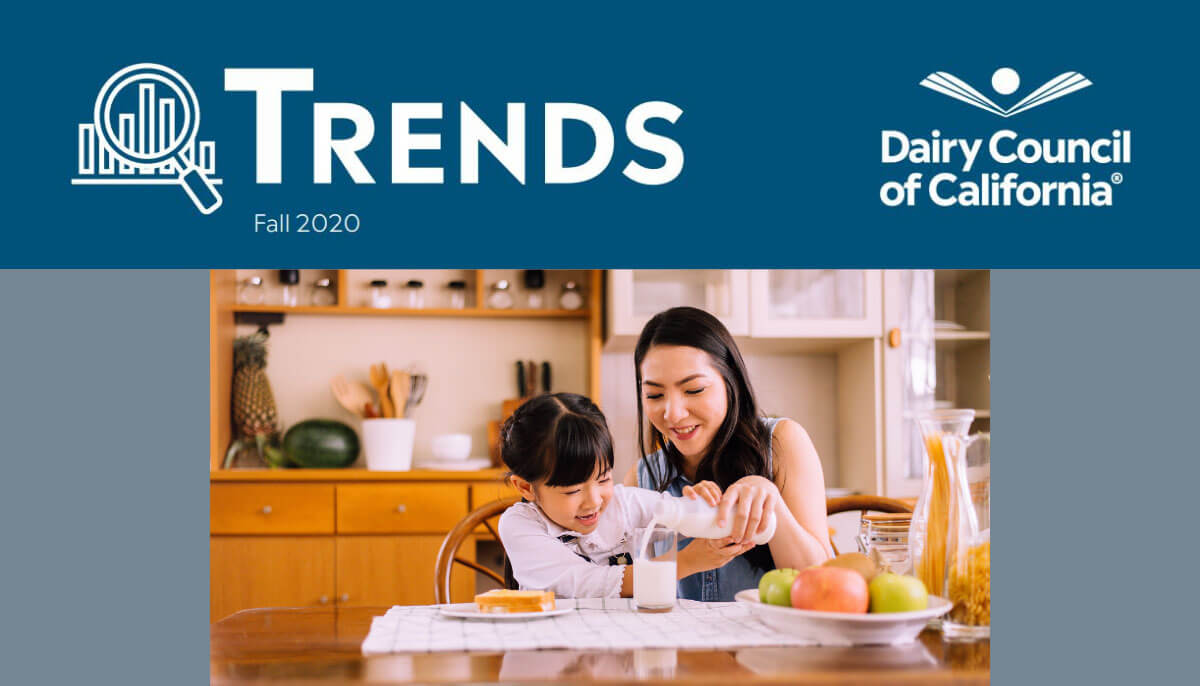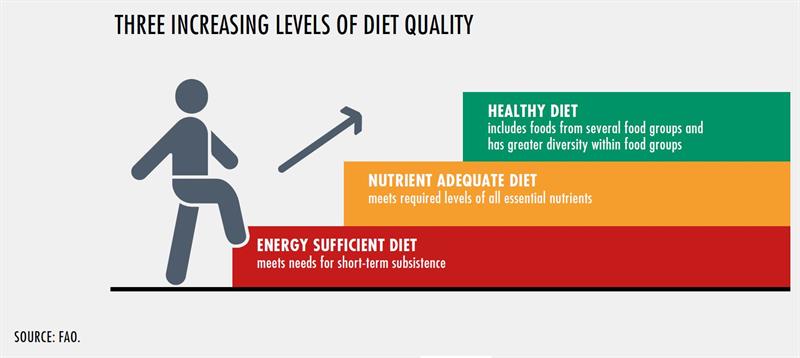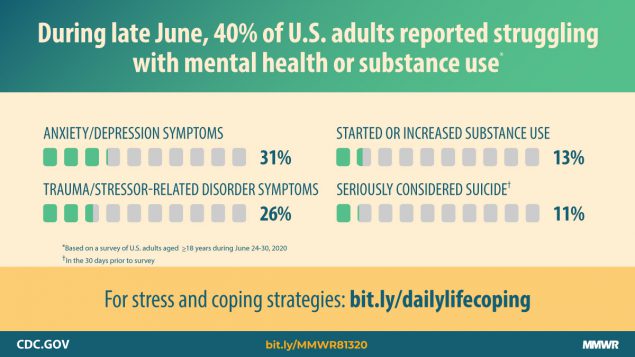Food and nutrition topics likely to impact the Dairy Community in the next 1 to 3 years.

 Nutrition guidance is expanding beyond individual nutrients to overall diet quality, addressing the unique needs of each life stage.
Nutrition guidance is expanding beyond individual nutrients to overall diet quality, addressing the unique needs of each life stage.
Guidelines for healthy eating continue to shift from a focus on individual nutrients toward food-based recommendations and building optimal dietary patterns. People eat different combinations of foods over time, rather than nutrients in isolation. The
synergistic effects of food in supporting optimal health are increasingly addressed in dietary recommendations that focus on consistent patterns of healthy food consumption. High-quality foods create the foundation for healthy eating patterns. Choosing
foods based on overall nutrient density has a greater impact on health than food choices that focus on a single substance such as a vitamin, calories or sugar. At the same time, sugar content in foods and beverages continues to be top of mind for
most consumers, as nearly three-quarters are trying to limit or avoid sugar in their diet.1 However, not all sugar is created equal, and evidence shows that using it as an indicator of carbohydrate’s impact on health is highly dependent
on the food source, or the food matrix—the composition of nutrients within a food. For example, high-quality carbohydrate food sources that contain sugar, such as yogurt, fruit, 100% fruit juice and some breakfast cereals are shown to be beneficial
to health. These foods contain beneficial nutrients and naturally occurring sugars, in addition to limited added sugars. Conversely, calorie-equivalent substitutions of low-quality carbohydrate foods with sugar, including sugar-sweetened beverages,
show evidence of harm.2 This scientific insight supports the shift of guidance to focus on the quality of foods and overall dietary patterns rather than looking just at food quantity and single nutrients.  There
is also a shift in the focus on nutrition and dietary patterns within and across life stages. Each life stage, from birth to older adulthood, requires distinct guidance to meet the unique nutritional and health needs of that stage. Dietary guidelines
aim to be seen not as prescriptive but rather as flexible, and applied to an individual’s life stage, while focusing on how foods can meet nutritional needs. This shift was notably addressed in the new recommendations by the Dietary Guidelines
Advisory Committee. Not only did the committee define life stages and include the populations of pregnancy, lactation and birth to 24 months, but it also added a new category of food components that pose a public health concern to address the special
needs of these populations, such as choline for pregnant and lactating women. The lens of applying nutrition guidance to life stages will continue to shape nutrition research for the coming years, as evidence will build on the understanding of food
quality and dietary patterns across the lifespan.
There
is also a shift in the focus on nutrition and dietary patterns within and across life stages. Each life stage, from birth to older adulthood, requires distinct guidance to meet the unique nutritional and health needs of that stage. Dietary guidelines
aim to be seen not as prescriptive but rather as flexible, and applied to an individual’s life stage, while focusing on how foods can meet nutritional needs. This shift was notably addressed in the new recommendations by the Dietary Guidelines
Advisory Committee. Not only did the committee define life stages and include the populations of pregnancy, lactation and birth to 24 months, but it also added a new category of food components that pose a public health concern to address the special
needs of these populations, such as choline for pregnant and lactating women. The lens of applying nutrition guidance to life stages will continue to shape nutrition research for the coming years, as evidence will build on the understanding of food
quality and dietary patterns across the lifespan.
Implication: Dairy foods remain a critical component of food-based dietary guidelines. Milk, yogurt and cheese are high-quality foods that provide essential nutrients for all ages. The focus on meeting the unique nutrient needs of various life stages provides an opportunity to highlight dairy foods’ contribution to optimal health across the lifespan.

With a pandemic upending daily life in communities across the nation and around the world, consumers, health professionals and researchers alike are looking to better understand the role of nutrition on immunity. The novel coronavirus heightened interest
around the potential immunological effects of foods, with scientists studying how specific food components may play a role in immunity, inflammation and infections. A growing body of research on the link between food and the gut microbiome is
shedding light on foods’ impact on inflammation and chronic disease. At the same time, there is emerging interest in foods and their association to infectious diseases like COVID-19. An example is an uptick of studies examining the potential
role that lactoferrin may have in prevention and possibly even treatment of infectious diseases such as COVID-19. Lactoferrin is a nutrient found in dairy and other mammalian milk and is known to have antibacterial and antiviral properties. Specifically,
some evidence points to lactoferrin’s ability to counteract coronavirus infections and inflammation by blocking the entry of a virus and preventing it from attaching to the host’s cells.4,5 While the science on lactoferrin and
coronaviruses is still too new to draw conclusions, it highlights the advances in understanding of how the foods people eat and the components that make up a food can impact human health, including both acute and chronic disease prevention and
treatment.
Heightened interest in immunity is increasing both consumer and food companies’ awareness of functional foods and ingredients that have additional benefits to health beyond basic nutrition. Consumers are shifting their purchasing
behaviors, valuing foods that have health benefits such as immune-boosting properties. One survey found that 57% of global consumers are more concerned about their immunity due to COVID-19.6 Another recent report found that nearly one-third
of consumers are eating more functional foods or beverages.7 Probiotics found in fermented foods like yogurt and kefir continue to be favored among functional ingredients for their well-documented role in supporting gut health. Scientists
are uncovering a lesser understood functional component of fermented foods—postbiotics. Postbiotics are biological compounds produced by bacteria during the fermentation process of a food or beverage, and they may have various benefits in
the gut.8 Postbiotics continue to be examined by scientists to better understand their impact on the human gut and immunity, helping expand knowledge of the positive role fermented foods play in dietary patterns.
Implication: Consumer interest in health and the immune-boosting properties of different foods will likely continue after the pandemic. Dairy foods provide inherent functional benefits due to the dairy matrix, a natural package of nutrients not found in any other food. This creates an opportunity for the dairy community to highlight dairy foods as an important component of daily food choices that can support optimal health.
 Due
to the effects of the pandemic, social and emotional needs of individuals are changing and impacting their overall health.
Due
to the effects of the pandemic, social and emotional needs of individuals are changing and impacting their overall health.The COVID-19 pandemic has severely impacted the social, emotional and physical health of all Americans. A recent report from the Centers for Disease Control and Prevention found that over 40% of Americans—or greater than four in 10—have faced mental health challenges such as anxiety and depression related to COVID-19.9 Another survey from Johns Hopkins University found that mental health disorders have tripled during the pandemic with the largest increase occurring among young adults 18–24 years old.10 There is no question that this infectious disease and the resulting disruption to daily lives has exacerbated a wide range of mental health issues.

The urgency for solutions to mental health concerns is evident through the emerging field of nutritional psychiatry. Research continues to expand the understanding of the link between nutrition and mental health. Many psychiatrists recognize this link and have begun using nutrition as part of the treatment strategy for various mental health conditions. For example, probiotic therapy has been found to ease depressive symptoms.11 In addition to supplements, probiotics can be found in fermented foods such as yogurt. The connection between what people eat and how it impacts mental health will continue to elevate the importance of healthy eating patterns in an individual’s overall health and well-being.

Although all Americans have experienced the consequences of the pandemic, disparities have intensified for vulnerable populations as those who already had difficulty accessing resources such as food, health care and technology find themselves struggling even more. Feeding America reported that 17 million more Americans are struggling with food insecurity than before the pandemic and that the number will continue to grow.12 Children are particularly vulnerable to the long-lasting negative effects of the pandemic. Disruptions to food access, education and socializing opportunities can have long-term consequences on children’s physical and emotional health, well-being and academic success. Students cannot engage and learn effectively until their basic physical and psychological needs are met. Educators and health professionals alike are searching for solutions to combat the negative impacts of the pandemic for children across the country. Food security and good nutrition, while always important, have become critical interventions for addressing the whole child.
Implication: For decades the dairy community has supported efforts to combat food insecurity. Specifically, milk and dairy foods are a vital component of federal meal programs such as school meal programs that support the health of children and their families. Milk and dairy foods are also a valued source of important nutrition at food banks and pantries. The dairy community’s contribution to these programs is more important than ever. Milk and dairy foods will continue to be valued as a solution to address the social, emotional and physical impacts of food insecurity.

America is currently dealing with multiple crises related to the novel coronavirus, as well as heightened health, racial and economic inequities. The systems and sectors that impact daily life, including health care, education and business, are being placed at the forefront to help solve these interrelated issues. Grassroots activism is growing to levels never seen before. The result is an open environment of sharing voices and experiences and seeking collaboration to find solutions for these unprecedented and interrelated crises.
Within the health care field, a growing shortage of physicians and other providers is expected to continue over the next 15 years. Moreover, Black and Hispanic doctors continue to be underrepresented.13 In the field of dietetics,
the demographics of registered dietitian nutritionists do not match the populations served. These issues can culminate in consequences that potentially harm vulnerable populations, such as reduced access to health care, lower quality
treatment and reduced ability to build rapport among patient and provider.14  Anticipation
for the next Dietary Guidelines for Americans, released every five years, has also raised the issue of diversity and equity within public health systems. There have been growing calls for nutrition guidelines to meet the needs
of a country that is increasingly diverse by building in messaging that includes foods that are culturally relevant across different racial and ethnic groups. There are also calls for the dietary guidelines to be more inclusive
of disadvantaged and minority groups, including those with chronic diseases. The Dietary Guidelines is currently intended for the general population of healthy individuals; however, the majority of Americans have multiple chronic
diseases. Currently, six in 10 American adults have a chronic disease such as diabetes, heart disease or obesity, while four in 10 Americans have two or more chronic conditions.3 These health disparities are felt more by people
of color and within socio-economically disadvantaged communities. In its recent report, the Dietary Guidelines Advisory Committee addressed the need for future guidelines and research to reflect the diversity of the nation and
to address issues around implementing guidelines to include more of a focus on food access and nutrition education. The report emphasizes that the guidelines are not intended to be a prescriptive dietary formula but rather an adaptable
framework that can meet many cultures, budgets and preferences.3
Anticipation
for the next Dietary Guidelines for Americans, released every five years, has also raised the issue of diversity and equity within public health systems. There have been growing calls for nutrition guidelines to meet the needs
of a country that is increasingly diverse by building in messaging that includes foods that are culturally relevant across different racial and ethnic groups. There are also calls for the dietary guidelines to be more inclusive
of disadvantaged and minority groups, including those with chronic diseases. The Dietary Guidelines is currently intended for the general population of healthy individuals; however, the majority of Americans have multiple chronic
diseases. Currently, six in 10 American adults have a chronic disease such as diabetes, heart disease or obesity, while four in 10 Americans have two or more chronic conditions.3 These health disparities are felt more by people
of color and within socio-economically disadvantaged communities. In its recent report, the Dietary Guidelines Advisory Committee addressed the need for future guidelines and research to reflect the diversity of the nation and
to address issues around implementing guidelines to include more of a focus on food access and nutrition education. The report emphasizes that the guidelines are not intended to be a prescriptive dietary formula but rather an adaptable
framework that can meet many cultures, budgets and preferences.3
The education systems that teach children are also community hubs, working to address the inequities many families face. School leaders are looking
to approach social, emotional and academic development through an equity lens by creating learning environments that consider the needs of the whole child. The consequences of these interrelated crises can also impact the long-term
health and well-being of teachers, leading for calls to prioritize teacher wellness. With the shift to virtual learning, parents are now playing a larger role in their children’s education, which can create opportunities
to strengthen the relationship between schools and families.
Implication: Dairy foods have been an important part of cultures around the globe for centuries, contributing to healthy eating patterns and family traditions for generations. The dairy agricultural sector, including producers and processors, can continue to play an integral role in providing nutritious foods while meeting the diverse needs within their communities.
 Accelerated
by COVID-19, rapid evolution and adoption of technology has changed how business is done. Remote environments will fundamentally change education, health and business infrastructures.
Accelerated
by COVID-19, rapid evolution and adoption of technology has changed how business is done. Remote environments will fundamentally change education, health and business infrastructures.The 21st century has brought many advances in technology that significantly shaped the landscape of every aspect of how humans operate across the globe. However, with an unparalleled pandemic keeping most people at home, technology
is changing the way individuals connect in all aspects of their lives. In all sectors, including business, education, health and others, individuals are adapting to the many pandemic-related disruptions, and technology is facilitating
that change.
Businesses and schools across the state, nation and world rapidly adopted virtual learning and telecommuting at the start of the pandemic. Both large and small businesses have shifted operations
as employees work remotely from home. Many are evaluating possible long-term benefits such as cost savings in rent or the ability to recruit talented employees without being limited by location. Schools have also been grappling
with distance learning while figuring out how to address the technological divide experienced by low-income students. This has led to non-traditional partnerships and support from large businesses and tech companies, providing
schools with the technological resources and support that are critical to teaching children under these new conditions.  In
health care, telehealth overcame barriers that have long prevented provider and patient participation. Telehealth is the use of telecommunications technology for remote health care delivery, such as video visits with a doctor,
email communications with a clinician or use of mobile health apps. In 2019, only 11% of Americans used telehealth. However, with most of the country sheltering in place, patients have embraced virtual health care, with 46%
of consumers now using telehealth in 2020.15 Telehealth isn’t new, but barriers formerly existed that made it difficult for widespread adoption; these included state regulations and policy-related barriers such as
limited reimbursement for telehealth providers and inconsistent licensure regulations. The pandemic has led many insurers and programs, including Medicare, commercial and private payers and some Medicaid programs, to temporarily
modify policies and rules to expand access to telehealth. While some barriers such as lack of high-speed internet access for rural communities still exist, the quick transformation of access to health care through technology
may be long-lasting.
In
health care, telehealth overcame barriers that have long prevented provider and patient participation. Telehealth is the use of telecommunications technology for remote health care delivery, such as video visits with a doctor,
email communications with a clinician or use of mobile health apps. In 2019, only 11% of Americans used telehealth. However, with most of the country sheltering in place, patients have embraced virtual health care, with 46%
of consumers now using telehealth in 2020.15 Telehealth isn’t new, but barriers formerly existed that made it difficult for widespread adoption; these included state regulations and policy-related barriers such as
limited reimbursement for telehealth providers and inconsistent licensure regulations. The pandemic has led many insurers and programs, including Medicare, commercial and private payers and some Medicaid programs, to temporarily
modify policies and rules to expand access to telehealth. While some barriers such as lack of high-speed internet access for rural communities still exist, the quick transformation of access to health care through technology
may be long-lasting.
Implication: The novel coronavirus brought both uncertainty and change to work, school and health care environments. Though the question of what will be a permanent part of society is unknown, it is likely that many changes will affect people well past the end of the pandemic. This makes collaboration between sectors critical for developing solutions to meet the technology needs of a rapidly changing society.

The far-reaching impacts of the pandemic have shifted the way consumers are eating and what they are purchasing. According to a survey by the International Food Information Council, more than eight in 10 Americans have altered
their food habits as a result of the coronavirus pandemic.1 The most common changes include cooking more at home, increased snacking, eating healthier than usual and thinking about and eating more food than usual.
Plant-based foods sales, including meat and cheese alternatives, tempeh and tofu, have outpaced total food retail sales during the pandemic.16 According to a survey by Mintel, more than half of consumers are
looking for a greater variety when it comes to plant-based proteins.17 However, the same survey found that despite growing interest in plant-based foods, the majority of those who state they eat meat believe that animal-source
meat is the best source of protein. Furthermore, consumers who identify as flexitarians, pescatarians, vegetarians and vegans agreed that animal meat is the best source of protein. Regardless, with more time spent at home
and less time eating out, consumers are shifting the way they think about food.
 Food
insecurity across income levels is rising and drastically shifting the way individuals and families access food. Across the country, there is a surging need for aid at food banks and food pantries as Americans face unemployment
and economic crises not seen in this generation. The number of people relying on food pantries has increased 150% compared with before the pandemic.18 According to a report by Feeding America, it is estimated that one
in four children—an equivalent of 18 million—may need food aid this year.11 Federal food programs have also required significant expansion. Enrollment in the Supplemental Nutrition Assistance Program (SNAP),
formerly known as food stamps, grew 17% in the first three months of the pandemic.19 Additionally, Amazon expanded its program for SNAP, allowing 90% of SNAP households to order groceries online20, as overall online
food purchases grew amid the pandemic. The COVID-19 pandemic also led to increased enrollment in the Special Supplemental Nutrition Program for Women, Infants, and Children, a trend that many experts think will persist
for years.
Food
insecurity across income levels is rising and drastically shifting the way individuals and families access food. Across the country, there is a surging need for aid at food banks and food pantries as Americans face unemployment
and economic crises not seen in this generation. The number of people relying on food pantries has increased 150% compared with before the pandemic.18 According to a report by Feeding America, it is estimated that one
in four children—an equivalent of 18 million—may need food aid this year.11 Federal food programs have also required significant expansion. Enrollment in the Supplemental Nutrition Assistance Program (SNAP),
formerly known as food stamps, grew 17% in the first three months of the pandemic.19 Additionally, Amazon expanded its program for SNAP, allowing 90% of SNAP households to order groceries online20, as overall online
food purchases grew amid the pandemic. The COVID-19 pandemic also led to increased enrollment in the Special Supplemental Nutrition Program for Women, Infants, and Children, a trend that many experts think will persist
for years.
Implication: Consumers’ heightened interest in food purchases and health, combined with a shift in eating habits, creates a meaningful opportunity for nutrition education. Dairy Council of California works to educate on the important role of nutrient-dense foods like milk and dairy foods, especially as they are readily available to vulnerable populations through federal meal programs.

The continuation of extreme weather events such as wildfires and poor air quality, as well as environmental conditions like water scarcity, have heightened the urgency to address climate change. Furthermore, the pandemic and
its consequential impacts on multiple aspects of health and equity exposed the need to broaden the dialogue around climate change. Multiple crises across the United States have unveiled the interconnectivity of environmental,
health, economic and social issues that relate to climate change. Finding solutions to address the larger, interconnected issues of climate change will take cross-sector collaboration. Those who work in food systems and
agriculture play a key role in finding solutions that support the health of populations and the planet.  Together,
extreme environmental events and the pandemic have disproportionately affected vulnerable populations. The health of these communities can be severely impacted by the disadvantages they face, and it is important to address
these disparities while also addressing the health of the planet. Elevating the role of nutrient-dense foods in meeting the health needs of populations while also contributing to sustainable solutions is critical. Environmental
crises lead to negative impacts on water, air, soil and biodiversity that worsen the nutritional prospects of vulnerable communities, particularly children, by limiting access to high-quality foods.21 The food and agriculture
sectors, through collaboration, can address sustainability by building solutions that will not only reduce their environmental footprint but also provide access to nutrient-dense foods so that communities can thrive.
Together,
extreme environmental events and the pandemic have disproportionately affected vulnerable populations. The health of these communities can be severely impacted by the disadvantages they face, and it is important to address
these disparities while also addressing the health of the planet. Elevating the role of nutrient-dense foods in meeting the health needs of populations while also contributing to sustainable solutions is critical. Environmental
crises lead to negative impacts on water, air, soil and biodiversity that worsen the nutritional prospects of vulnerable communities, particularly children, by limiting access to high-quality foods.21 The food and agriculture
sectors, through collaboration, can address sustainability by building solutions that will not only reduce their environmental footprint but also provide access to nutrient-dense foods so that communities can thrive.
Implication: Climate change solutions for an equitable and sustainable food system should address the critical elements of health and nutrition, culture, environment and economics. Milk and dairy foods contribute to healthy eating patterns, especially for people who experience food insecurity. The innovations of the dairy agricultural community to reduce environmental impact are yielding significant results, leading the way in regenerative agricultural systems, providing nutrient-dense foods to those who need them, and contributing to the economic livelihoods and health of local communities.